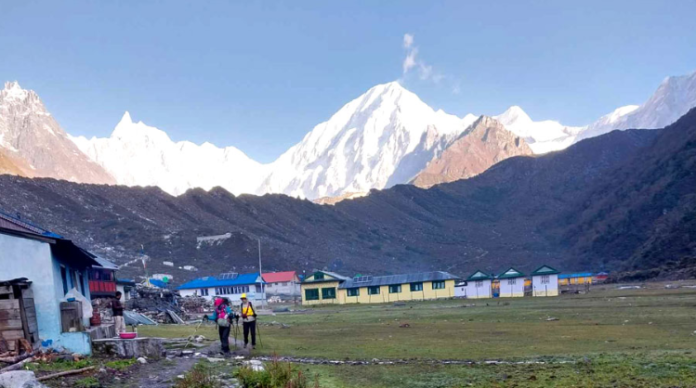The Manaslu Circuit Trek is one of Nepal’s most captivating and less-crowded high-altitude adventures. Nestled in the remote northern part of the country, this route circles around Mount Manaslu, the world’s eighth highest peak standing at 8,163 meters (26,781 feet). Although overshadowed by the Annapurna and Everest regions, Manaslu offers a perfect blend of cultural richness, scenic diversity, and challenging mountain terrain.
Introduction to the Trail
The journey typically begins in Soti Khola and concludes in Besisahar, winding through breathtaking landscapes, suspension bridges, cascading waterfalls, and deep gorges. Spanning around 177 kilometers (110 miles), the trail passes through subtropical jungles, alpine forests, and glacial valleys, gradually ascending to the dramatic Larkya La Pass at 5,160 meters.
Trekkers are treated to a constantly changing panorama—lush rice fields give way to rugged cliffs, and remote mountain villages reflect both Tibetan and Nepalese influences. The route lies within the Manaslu Conservation Area, a protected region home to snow leopards, red pandas, Himalayan tahr, and countless bird species.
Permits and Regulations
Due to its proximity to the Tibetan border and sensitive ecological areas, the Manaslu trek is designated as a restricted area. Trekkers must obtain special permits and travel with a registered guide through a licensed trekking agency. The key permits required are:
- Restricted Area Permit (RAP)
- Manaslu Conservation Area Permit (MCAP)
- Annapurna Conservation Area Permit (ACAP)
- Tsum Valley Permit (if detouring into Tsum Valley)
These regulations are in place to preserve the fragile environment and support local communities through sustainable tourism.
Cultural Tapestry
One of the highlights of the Manaslu Circuit Trek is its cultural authenticity. Unlike more commercialized trails, the villages here remain deeply rooted in tradition. Many settlements are inhabited by the Tibetan-origin Nubri and Tsum people, who practice Buddhism and lead agrarian lifestyles.
Along the trail, you’ll encounter monasteries, mani walls, prayer wheels, and chortens—symbols of Tibetan Buddhist heritage. Notably, the monastery in Lho and the serene atmosphere of Sama Gaun offer a unique opportunity to engage with the spiritual life of the locals.
The Trekking Experience
While the trek can be completed in 14–18 days depending on the itinerary, acclimatization is key. The route demands physical endurance and mental resilience due to long walking hours, changing altitudes, and minimal facilities in some areas.
A typical itinerary includes stops in:
- Soti Khola
- Machha Khola
- Jagat
- Namrung
- Sama Gaun
- Samdo
- Dharamsala
- Larkya La Pass
- Bimthang
- Tilije and Dharapani
Each location presents unique scenery and hospitality. Sama Gaun, for instance, is an ideal acclimatization spot with side trips to Manaslu Base Camp and Birendra Lake. The ultimate challenge—and reward—of the trek comes at Larkya La Pass, where trekkers are greeted with panoramic views of Himlung Himal, Cheo Himal, Kang Guru, and Annapurna II.
Why Choose Manaslu Over Other Treks?
- Fewer Crowds: Despite its growing popularity, the Manaslu Circuit remains relatively peaceful, offering a more intimate experience with nature and culture.
- Rich Biodiversity: The conservation area supports a diverse ecosystem with rare wildlife, exotic plants, and untouched forests.
- Cultural Interaction: With traditional villages and Tibetan influence, you can deeply engage with indigenous customs and practices.
- Raw Adventure: Compared to commercialized trekking routes, Manaslu feels more adventurous, with limited infrastructure but unmatched authenticity.
Best Time to Go
The ideal seasons for the Manaslu Circuit Trek are spring (March to May) and autumn (September to November). During these months, the weather is generally stable, skies are clear, and the visibility is superb. Rhododendrons bloom in spring, while the post-monsoon autumn offers crisp mountain air and golden terraced fields.
Winter treks are possible but come with risks such as heavy snowfall and closed passes. Monsoon season, from June to August, is not recommended due to slippery trails and landslides.
Food and Accommodation
While basic, food and lodging options are available throughout the trek. Teahouses offer meals such as dal bhat, noodles, soups, momos, and occasionally western dishes. Accommodations range from simple wooden lodges to slightly more comfortable rooms in larger villages like Namrung and Sama Gaun. Carrying snacks, water purification tablets, and a warm sleeping bag is advised.
Tips for a Successful Trek
- Acclimatize properly: Spend extra nights at higher altitudes to avoid altitude sickness.
- Train beforehand: Build stamina and leg strength before attempting the trek.
- Pack smart: Lightweight gear, proper footwear, layered clothing, and first aid are essential.
- Travel with a guide: Not only is it required, but guides provide invaluable local knowledge and support.
- Respect local customs: Dress modestly, avoid wasting food, and always ask before taking photographs.
Environmental Responsibility
As with all high-altitude treks, it’s crucial to trek responsibly. Carry reusable water bottles, minimize plastic use, and pack out all trash. Support teahouses that use solar power and purchase locally-made goods. Sustainable tourism ensures that these pristine environments remain untouched for future generations.
Final Thoughts
The Manaslu Circuit Trek is a hidden jewel among Nepal’s trekking routes. Combining majestic scenery, rich cultural encounters, and physical challenge, it offers a rewarding experience for those seeking more than just a hike. With every step across suspension bridges, past prayer-flag adorned ridges, and under snow-capped giants, you’ll understand why Manaslu remains one of the Himalayas’ best-kept secrets.
If you’re seeking an off-the-beaten-path adventure with deep cultural immersion and jaw-dropping landscapes, the Manaslu Circuit might just be your perfect next trekking destination.

